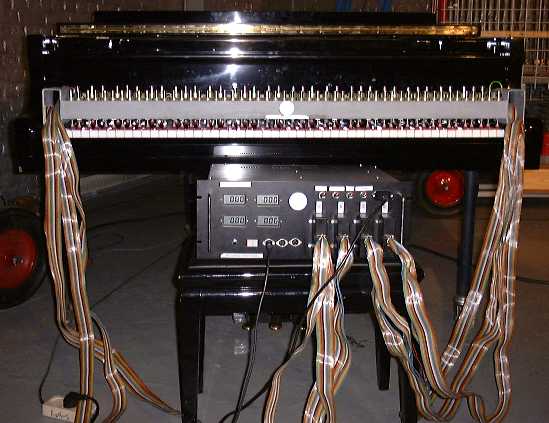
<Jumpy Variations>
for player piano
by
Godfried-Willem Raes
1995

These variations arose from the interest I found in a particular arithmetic proposition that appears to be true and trustworthy, but nevertheless still belongs to the category of unproven propositions: Spoken out as a procedure the proposition presents itself as follows:
Take an integer. If it is even, divide it by the number 2. If it is odd, however, multiply it by the number 3 and add 1. Now, after any number of recursions, we always arrive back at the number 1.
Example:
take 15 :
40 / 2 = 20
Apart from the mystery around the difficulty of finding a proof for such a 'simple' proposition, the series of numbers this function generates intrigued me quite a bit. The number series is pretty adventurous and makes wide excursions, jumping up and down into extremely large numbers. Thus came the idea of using it as a basic algorithm for melodic and harmonic development in a musical composition.
Although it would be quite possible though extremely tedious to compose these pieces by hand using pencil and paper, I preferred to use the computer and worked out an algoritmic composition program around the given rules. At the same time this offered me the chance to include the performance of the pieces and their interpretation as a part of the program itself. So I decided to score the piece for player-piano and immediately did'nt have to bother anymore about human performer bound limitations. The Jumpy variations are trully interactive: their interpretation is part of the performer, controlling the instrument remotely from behind the computer, running the Jumpy Variations algorithmic software. The original version of this software - written between 1992 and 1995 - was a multitasking MS-DOS program needing an Intel 80386DX processor. In 1999 I upgraded (and rewrote...) the software to take advantage of the higher processing power and easier memory handling provided by the Pentium II platform. The 1999 version thus became a full 32-bit application running under Win32 (Windows NT , 98 or 2000) and features a more flexible user interface. It is now part of my <GMT> real-time composition software. People interested in performing this piece can obtain the compiled software by simple email request to the author. However, a player piano (Vorsetzer by Trimpin or myself) or a disklavier or a QRS-playola is an obvious requirement for performing the piece.
The jumpy variations that have resulted from this work were called:
Each of those sections uses the principle of musical variations as a compositional procedure. Each variation revealing another run through the jumpy algorithm. The piece as such is pretty austere and belongs to the category of pure abstract music. It is not a 'landscape with cows', as I use to call most contemporary composition . The gestural aspects of the piece -in Tendering for instance the gesture is one of 'getting tender'- do offer audiences a chance to hook into the piece on a more embodied or expressive level. It is up to them however to do so or not to do so. The piece itself is'nt rhetoric and doesn't force into anything. Hence it is also fragile and vulnerable.
The second movement, the 'Tropes', uses a selected set of numbers for which the algorithm produces particularly interesting burst of melodic and harmonic development. Since the numbers produced tend to become extremely large, we used the logarithm of their logarithm as point of departure for the musical mapping on the piano keyboard.
The last section of these variations, Totems, puts the algorithm in a vertical format: it outputs discontinuous clusters in which each note/component gets an individually weigthed dynamic. The resonances in the piano can thus be controlled in a way that would be beyond the scope of any performer of flesh and blood. The clusters can be from 2 to 56 notes wide, their composition is based on very specific rules of harmonic evolution. The timing -beyond any sense of periodicity- is strictly calculated as a function of piano resonance and algorithmic logic.
The <Jumpy Variations> were recorded for CD in the Logos tetrahedron in august/september 1999 on a concert grand piano and are available on the Logos Public Domain series (LPD-004).
 Enquiries via e-mail
Enquiries via e-mail